As an Amazon Associate, I earn from qualifying purchases.
Today we are talking about all things whole wheat! From grinding your own flour, tips for creating light and airy baked goods, and of course my favorite whole wheat recipes.
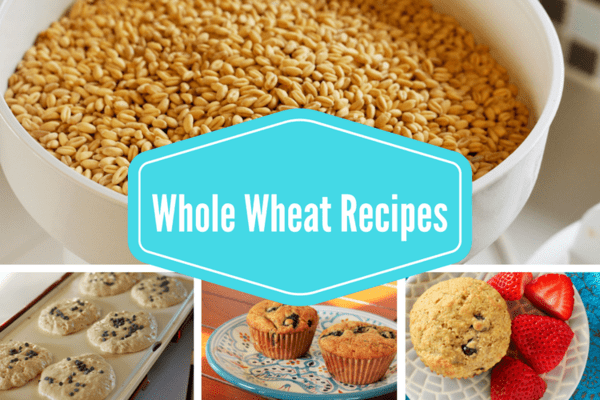
Back in 2012, when I realized how expensive flour was versus the cost of a grain mill, I decided to start saving for one. I saved, and saved, and saved, and was still probably about four months away from even thinking of being able to purchase one. Then, a random enormous Amazon box showed up one day, and you can imagine my surprise to find the grain mill of my dreams with a note that said “happy birthday AND Merry Christmas, love Anne”. Before you ask, Anne is not accepting applications for new friends.
For the last five years, I have been a proud owner of a Wondermill, but there are many options available. I know Kitchen Aid makes one that attaches to your mixer, but I feared that it would wear out my motor. Whatever your machine, they all essentially do the same thing – turn wheat berries in to flour. It can work with other grains too of course (corn, etc.), but mine has only been used as a basic flour mill.
Wheat berries that I purchase from Azure Standard are soft white, and hard white (which Troy tries to convince me was his nickname in high school. Not buying it.). Soft white is best used for baked goods like cakes, biscuits, cookies, pancakes, etc. I also use it for whole wheat pizza dough. Hard white is only used in our house for homemade bread.
The cost of wheat berries has doubled in the five years since I have been grinding wheat for whole wheat recipes. Soft white wheat berries on Azure are currently $45 for 50 pounds, and hard white/red runs about $43 for 50 pounds. Good thing I have approximately 4 billions pounds of it in my zombie pantry. I store my wheat berries in five gallon food safe buckets with Gamma seal lids, which keep the berries in an air and water-tight environment.
Organic whole wheat flour at the grocery store will run you $5-10 for five pounds. The general rule of thumb is that one cup of wheat berries is equal to about 1.5 cups of flour when ground. These mills are pricey, but if you bake like I bake, the “break-even” point is fairly soon. It’s actually immediate if your friend buys it for you. Ha!
In addition to the mill being cost-effective (eventually), there is also the flavor and nutritional factors to consider. Freshly ground flour is far superior in taste to store-bought. It has an almost “nutty” taste to it, and anything made with whole wheat flour keeps you fuller longer than items made from white flour. Additionally, there is convenience in that I never run out of flour in the middle of a baking project. Sure, I may need to grind some, but I’m not rushing to the store to track down whole wheat flour while trying to make pancakes.
The oils in wheat start to turn rancid quickly after grinding. So, the flour that is purchased from the store often has to be treated or processed to make it shelf-stable. For the purpose of disclosure, I still buy King Arthur bread flour from time to time, as I put 1 cup in each loaf of homemade bread that I make. I store big containers of the freshly ground flour in the freezer; it stays soft and fluffy and keeps the oils from getting icky. And I’m am able to grind less often. Unlike my teeth, which I grind every night. 🙁
The secret to making whole wheat baked goods that are as fluffy as white flour items, is a magical ingredient called vital wheat gluten. As the name implies…it is vital. 🙂 Simply add 1 tbsp of vital wheat gluten per 1 cup of whole wheat flour to any whole wheat recipes, and you’ll have improved results.
Now, if you’re not ready to invest in a grain mill, or simply have zero interest in ever grinding your own wheat, there are loads of great whole wheat flours available for purchase. If you’re looking to make pastries, cookies, or muffins, you’ll want to purchase “pastry whole wheat flour”. For breads, you’d want to buy regular whole wheat flour.
Let’s take a tour of the Wondermill
Here is the base of the grinder: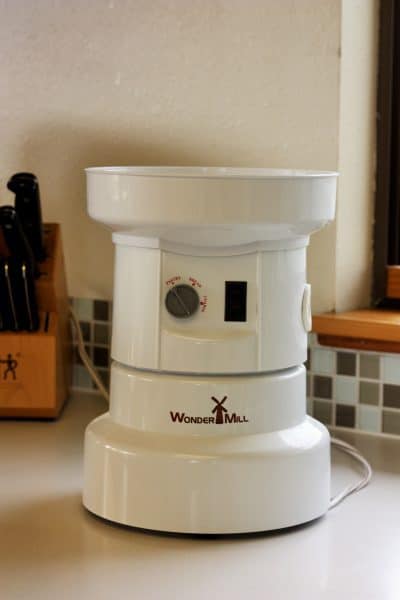 The lid of the grinder goes on the flour bucket. Flour bucket is not the technical term. This isn’t food mill porn (well it kinda is). The gray hose goes in the hole. It’s a tight fit. That’s what she said.
The lid of the grinder goes on the flour bucket. Flour bucket is not the technical term. This isn’t food mill porn (well it kinda is). The gray hose goes in the hole. It’s a tight fit. That’s what she said.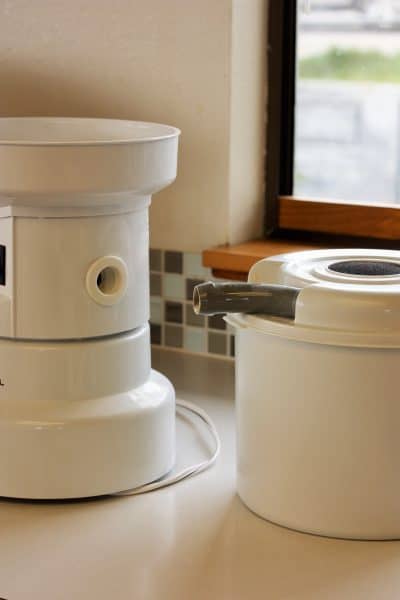 Lest you forget, you need to turn on the mill before adding the grain. That’s what she said.
Lest you forget, you need to turn on the mill before adding the grain. That’s what she said.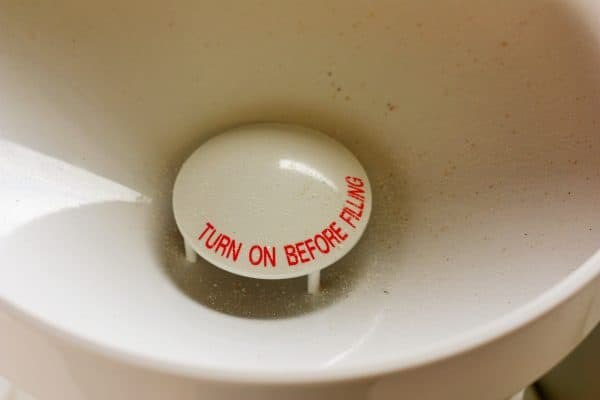 I always grind everything on the “pastry” setting for a finer flour. Hit “on”, and let it go for a few minutes, and voila, flour.
I always grind everything on the “pastry” setting for a finer flour. Hit “on”, and let it go for a few minutes, and voila, flour.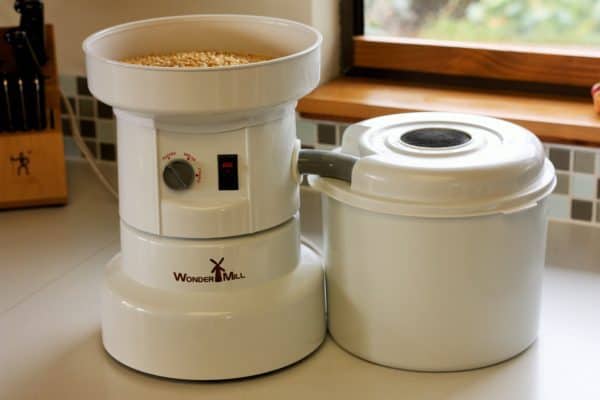
- Whole Wheat Banana Chocolate Chip Muffins
- Whole Wheat Blueberry Muffins
- Whole Wheat Orange and Chocolate Madeline Cookies
- Whole Wheat Pancakes (blueberry options)
- Whole Wheat Red Lobster Cheddar Bay Biscuits
- Whole Wheat Sandwich Bread
- Whole Wheat Waffles
If you’re thinking of adding a grain mill to your kitchen, I’d highly recommend it! It allows for versatility in cooking so many whole wheat recipes, and delicious meals. I’m happy to answer any questions you might have about the ins and outs.
That’s what she said.

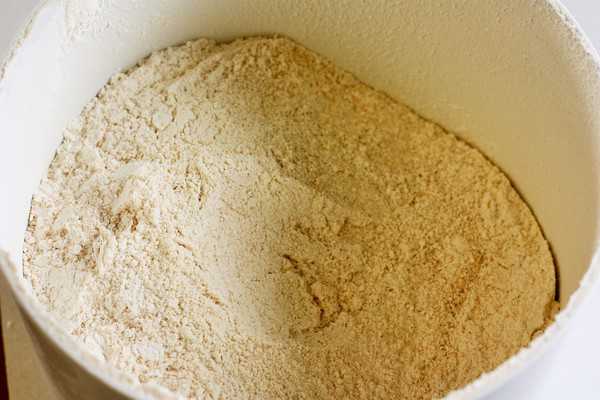






ANY IDEAS OF WHERE TO BUY WHITE WHEAT IN ATLANTIC CANADA?
I thought buying wheat from Azure was a great deal, until got to the checkout. $30 just for shipping! How do y’all avoid the shipping fees?
You have to join a route group. Call Azure, give then your address and they’ll tell you the closest route group. If your order is over $50, and the group’s order is over $550, they deliver to your drop site for free. Since I started ordering in 2011, I’ve never paid shipping once. The downside is you typically have to wait 1-2 weeks until the next drop day.
I just came across your blog and I really enjoyed reading it! I found this post about wheat and I really liked what you said. I just thought I would let you know that my dad cleans and sells his own wheat and his prices are a lot lower then what you have mentioned here. He just started his web page and it is http://www.davesfarms.com. He sells his wheat for $13.00 for a 50 lb bag. He does charge a dollar per item to deliver it. He does buckets as well for $20 for a 45 lb bucket.
I’m adding this to my list of favourite blogs. 🙂
Can you use a Food Processors to grind wheat?
Charlene Wagner
Correction – $13 for a bucket of wheat berries
The weight of the flour doesn’t increase, but the volume does by 50%. We are paying $13 for a 26# bucket of whole wheat flour. White Pillsbury restaurant flour is $15 for 25 # at the warehouse store. Whole wheat is more expensive, since the warehouse doesn’t carry it (due to short shelf life, I assume). We use a Victorio hand mill, which makes a cup in about 5 minutes. 3 cups of flour makes a 1.5 pound loaf of bread. 1# of gluten is about $4 and makes about a dozen loaves of bread. The flour is slightly less expensive to grind yourself, but immensely more flavorful and nutritious. Plus you can grind other grains, like oats, millet, flax, or even lentils or beans to add protein to your bread. My kids prefer homemade bred to storebought.
So…you mentioned how expensive flour is….but wheatberries seemed to be even MORE expensive…so between the initial outlay for the mill, the price of wheatberries AND the labor involved……I take it milling your own wheat will cost you, much, much more in the long run……no??
It seems expensive if you assume that 50 lbs of wheat berries = 50 pounds of flour. But it doesn’t.
The math isn’t something I’m good at, so see this link: https://heavenlyhomemakers.com/how-many-cups-of-flour-in-a-pound-of-wheat.
I buy soft white from Azure Standard for $19.15 for 50 pounds ($.39 a lb for berries which equals about 1.5 pounds of flour), and hard white for $32.40 for 50 pounds ($.65 a lb for berries which equals about 1.5 pounds of flour).
If you wanted to buy organic, all US grown whole wheat flour, it would be about $5 for a 5 pound bag. Any way you do the math, I’m still paying way under that. And since whole wheat flour goes rancid quickly, I’m also getting fresh flour that isn’t treated to prevent it from going rancid.
I hate to say it, but a pound of wheat berries equals a pound of flour, you don’t add to or take away weight when you grind it
Physics be damned!
Oh girl ….I am glad I happened upon your site! I am wanting a more frugal simple life! You made me laugh out loud and read it to my husband..(…who by now after hearing hours of talk about how I want to grow grapes and plant more fruit trees, add 9more months to my stockpile….and rabbit hutch…) well I think he’s just ignoring me! .anyway I live in Missouri and am wanting to buy hard red wheat….but don’t know where!!! Can u help this newbie!?
Ok, a few ideas as you don’t have Azure:
1) Is there a food co-oop in town?
2) Do you have any Amish stores?
3) https://store.honeyvillegrain.com/wheat.aspx#.UPTU8aPhd7Q
Just bought a deluxe victorio hand grinding mill from amazon around $84. It takes a little work, but I figure it will help keep my saggy arms toned. I can grind about 5 cups in 25 min. Now I’m just searching for the perfect whole wheat sandwich bread recipe any ideas?
Here you go! https://www.sustainablecooks.com/2010/11/make-some-dough-to-save-some.html
Kalla, I wish you were in Canada. I’d see about buying your hand mill from you! 🙂
Hi Chantal,
I see you live in Canada. Can I ask where do you get your wheat berries from?I’m in Nova Scotia and finding it a bit hard to get info on line. Thank you very much.
Andrea
I bought whole wheat about 20 years ago and it’s still doing just fine. It needs to have the right % of moist left after they dry them. Between 10-13% is perfekt for longtime storage. Mine are stored in HUGE plastic buckets with air-tight lids.
The link above doesn’t work, but if you go to the homepage you can can click your way around it. I bought a pouch-sealer there in which I store flour for up to ten years with.
In general- if the wheat is whole and rightly stored you can use for thousands of years after it was stored in the first place.Thats why I love whole wheat so much. It doesn’t need to be rotated 🙂
I am new to this blog, I live in Sweden and I just LOVE it. Thank you for all your funny, but very informative tips, directions and all that you share on this site. Thank you, Thank you Thank you (sucking up a bit)
I am really sure I will save up to getmy own mill. I have a old one that is milled by hand- but I have ony used i once… it’s hiding in the darkest corner in the forgotten cupboarad… in the land of Nog…
Love to have found a Sister so far far away:)
Big Hugs
Linda
I cant access the links above, I would love to check them out.
To answer someone’s question about UNground wheat berry’s shelf life, it can easily last for 20 years if stored correctly without oxygen making it great for long term storage. My Mom says after that the nutrition goes down, but it is ok to use. In fact, wheat stored by the Egyptians has been found and it is still good today and I think the quality is intact too. You can can it, store in plastic buckets, or pouches.
The link below is to an organization mostly run by volunteers and they try to keep prices low. They also have local cannerys that are open to both members and the public and sell very limited storage items and will let you use their facilities for free to dry pack can. I think you can bring your own food to can too. Look up “LDS Bishop Storehouse (your are)” or contact a Mormon and they should be able to help you get in contact with the right person. https://store.lds.org/webapp/wcs/stores/servlet/Product3_715839595_10557_21003_-1__195615
Here are oxygen absorbers https://store.lds.org/webapp/wcs/stores/servlet/Product3_715839595_10557__-1__195877
“turn on before filling”? Now THAT’S what she said?..sorry couldn’t resist
If I’m ordering a million pounds of wheat berries on azure.. how many pails/lids do I need to order to store each 25 lbs. of berries in (2 or 5 gallon)?
I figure it’s a great way to kick-off no spend March, buy a ton of wheat berries and a grain mill!
You know how to celebrate a no spend month in style! LOL.
You definitely want the 5 gallon buckets! I think a 50 lb bag of wheat berries fills about 2.5 5 gallon buckets.
Not into Adam Levine, but to each his own!
Do you have a great sandwich bread recipe that is toddler approved for PB&J?
this is my bread recipe: https://www.sustainablecooks.com/2010/11/make-some-dough-to-save-some.html
I’ve made some changes since I first started, but the basic recipe is good too!
I now use a pinch more olive oil, 1 cup of King Arthur bread flour, 5 cups of whole wheat flour, and 5 tblsp of vital wheat gluten.
Also, Adam Levine is all kinds of hot (in a really dirty, sleazy way). Come on, who’s with me??
Adam Levine is yummy (in all the right and wrong ways) to the extreme- except when he went blonde- that was gross. 🙂
I love you, you hippy
Why do you add purchased flour to your homemade bread? Please forgive me if you’ve already addressed this!!! Also: HOW can you make writing about grinding your own wheat funny? This is hilarious. And now I’m off to browse amazon. I had just made the adjustment to admitting that I’m ready to make my own bread, now I need to take that one step further… Thank you. (I think.) As always, your blog ROCKS!
I love the rise that King Arthur bread flour (in the blue bag) gives to homemade bread. It makes it extra fluffy. KA is a great company as well.
While I love my grinder and think everyone should have one, I’d encourage you to try to make your own bread a few times before shelling out the money for a grinder.
can i grind hard wheat berries to make my own vital wheat gluten flour? i want to be able to make seitan with my wonder mill